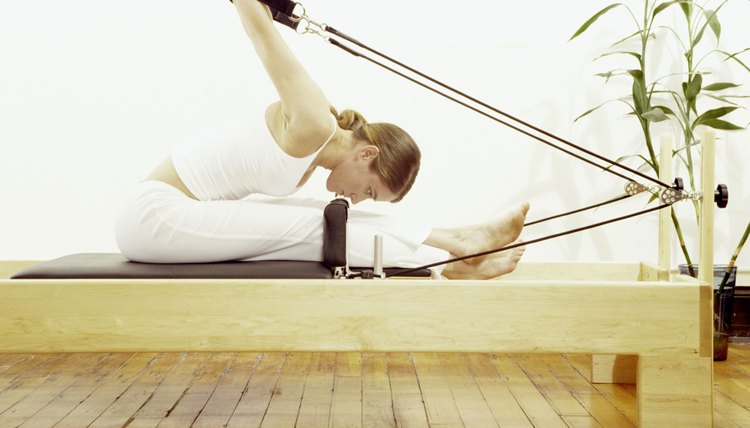Which Exercises in Pilates Use Neutral Spine?

When Joseph Pilates created his signature exercise technique, he believed “the spine should be flat like a newborn baby.” Decades after his death, physical therapists informed you that your spine has three shock-absorbing curves, and that a healthy spine functions more like a curved spring and less like a straight rod. Used in some Pilates exercises, but not in others, the neutral spine alignment maintains the natural spinal curvatures.
Finding Neutral Spine
To find your neutral spine, lie supine with your knees bent and feet flat on the floor. Rock your pelvis forward and backward, allowing your lower back to arch and flatten. When you find an alignment between the two extremes, your spine will be in a neutral position, with a small curve in your lower back and neck area, and your middle back imprinted into the floor. This position uses your deepest core muscles for support. If you tilt your pelvis and press your back into the floor, your back and butt muscles take over, and your core gets lazy.
Imprint vs Neutral
Pilates instructors like Moira Stott Merrithew believe that the imprinted or flat spine has its place. When lying supine with both legs lifted and extended, tight hip flexors and weak core muscles cause excessive lower-back curvature. Imprinting your back into the floor protects it under these circumstances. Otherwise, maintain a neutral spine in any supine exercise where at least one foot maintains contact with the floor.
Leg Circles
During leg circles, you assume a supine position, with one leg extended into the floor. The other leg, raised to a 90-degree angle, performs small circles, as if you were tracing a quarter on the ceiling. Imprinting your back during this exercise causes a pelvic tilt, which tightens your hip flexors and restricts your range of motion. Given the general tendency of your hip flexors to overwork, any alignment that causes them to work harder is counter-productive.
Ab Exercise Modifications
Some instructors want students to eventually maintain neutral spine in all positions, even supine, with legs lifted and extended. They modify the supine series by having clients bend their knees and place their feet flat on the floor. These modifications are less likely to produce a hyperextended spine. To modify the crisscross exercise, for example, lie supine with knees bent and feet flat. Lift your right knee, simultaneously rotating your upper body so your left shoulder moves toward your right hip, and vice versa. As your abs get stronger, raise your legs, bicycling them as you rotate your upper torso and maintain a neutral spine.
Side-Lying Leg Work
The side-lying leg series also uses a neutral spine. Lie on one side, with hips stacked, and one leg on top of the other. Lift your top leg to hip height, keeping your knee facing straight ahead. Rest your head on your bottom arm and place your top hand in front of you on the mat. Contracting your abs for spinal stability, swing your leg forward and backward. When done correctly, the pelvis looks like it has two eyes, facing directly ahead. Don't cheat. Tilting your pelvis to stabilize your back uses your back instead of your core.
The Leg Pull
The leg pull, another neutral spine Pilates exercise, uses a pushup position., Keeping your shoulders relaxed and your neck in alignment with your spine, contract your abs and butt muscles, and lift one leg a few inches from the floor. Although easier said than done, maintaining a neutral spine keeps your core muscles active, while placing your wrists in a safe, ergonomic position. Sagging your spine, or trying to prevent sagging by tilting your pelvis, disengages your core and displaces the weight on your wrists. Do fewer reps, and stop when you can no longer maintain neutral spine.
References
Writer Bio
In 1999, Lisa Mercer’s fitness, travel and skiing expertise inspired a writing career. Her books include "Open Your Heart with Winter Fitness" and "101 Women's Fitness Tips." Her articles have appeared in "Aspen Magazine," "HerSports," "32 Degrees," "Pregnancy Magazine" and "Wired." Mercer has a Bachelor of Arts in psychology from the City College of New York.
